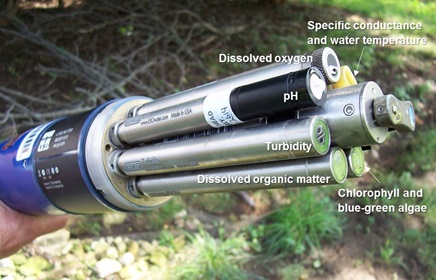|
|
What are these measurements?

Multi-parameter monitor used to record water-quality measurements.
- Water temperature is measured using a thermistor and reported as degrees Celsius. Temperature is an important measurement for habitat and recreation and affects the rates of chemical and biological processes. Click to convert a water temperature from degrees Celsius to Fahrenheit.
- Specific conductance is a measure of the capacity of water to conduct an electrical current at a standardized temperature of 25 degrees Celsius and is reported in microsiemens per centimeter. It is affected by the types and amounts of dissolved substances in the water. Water that has no dissolved solids has a specific conductance of 0. This measurement is used to estimate the concentrations of dissolved solids or salts (salinity) in water. Large daily variations are possible in estuaries or other locations affected by tidal interactions of fresh and salt water.
- pH is a measure of how acidic the water is and is reported in standard units. It is an important indicator of water quality because it directly affects water treatment, chemical reactions, and basic functions of plants and animals.
- Dissolved oxygen (DO) concentration (reported in milligrams per liter) in surface water is a significant factor in chemical reactions and the survival of plants and animals in the water. It is related primarily to exchange with overlying air, photosynthesis by algae and plants in the water, and respiration of aquatic organisms. Extended periods of time with low dissolved oxygen (less than 5 milligrams per liter) can cause fish and other aquatic organisms to perish.
- Turbidity refers to the cloudiness or murkiness of the water and is reported as nephelometric turbidity units (NTUs) or formazin nephelometric units (FNUs). The larger the turbidity is, the more murky the water appears. Turbidity is caused by suspended particles, primarily clay, silt, organic matter, and microscopic organisms. Turbid water is not necessarily harmful, but the particles or sediments can also cause problems. Sediment can negatively affect aquatic life (clogging fish gills). Particulates and especially organics can contribute to low DO. Metals, bacteria, and toxic organics can be adsorbed on particles and particles can be coated with metals oxy-hydroxides.
- Nitrate is a common form of nitrogen and is important because it affects plant growth and, in excess, contributes to eutrophication and human health concerns. It is measured in milligrams per liter. Nitrate usually is measured with an instrument that is separate from the multi-parameter monitor.
- Chlorophyll is the green molecule in plant cells essential for photosynthesis, and is often used as an indicator of algal biomass in water. Chlorophyll sensors rely on fluorescence, which is the emission of light by a substance that has absorbed light. Measurement units include relative fluorescence units (RFU) and micrograms per liter (ug/L). Chlorophyll sensor data provides information on relative patterns, but need to be related to laboratory-measurements to provide information about actual chlorophyll concentrations. Large daily variations in sensor measurements that are not related to chlorophyll concentrations may occur due to changing light and temperature conditions, which affect the fluorescence response of algal cells.
- Sensors are becoming more common for recording other water-quality measurements such as dissolved organic matter, chlorophyll, and blue-green algae.
For more information on the instruments used to make these measurements consult the USGS National Field Manual (http://water.usgs.gov/owq/Fieldprocedures.html)
|

